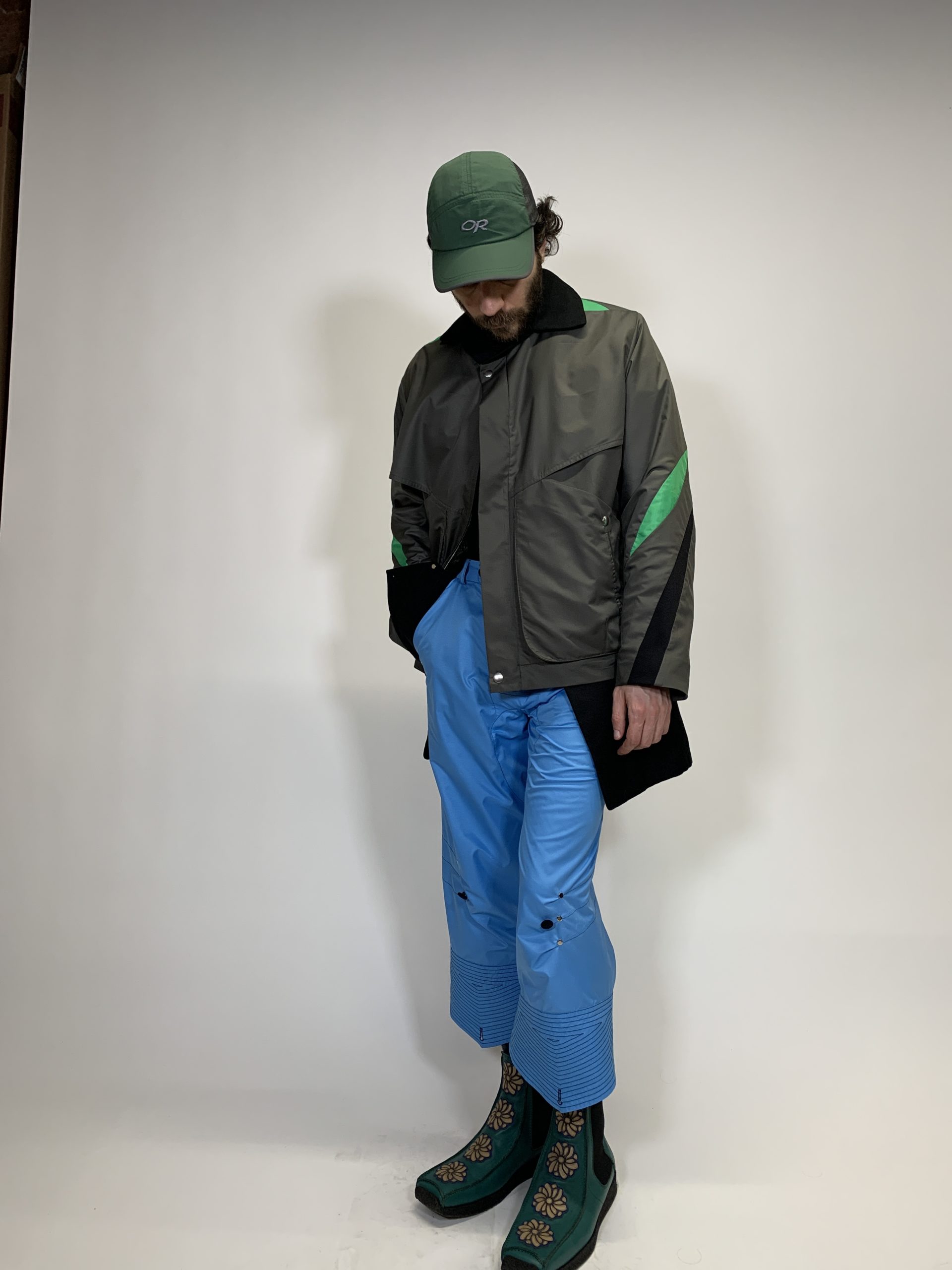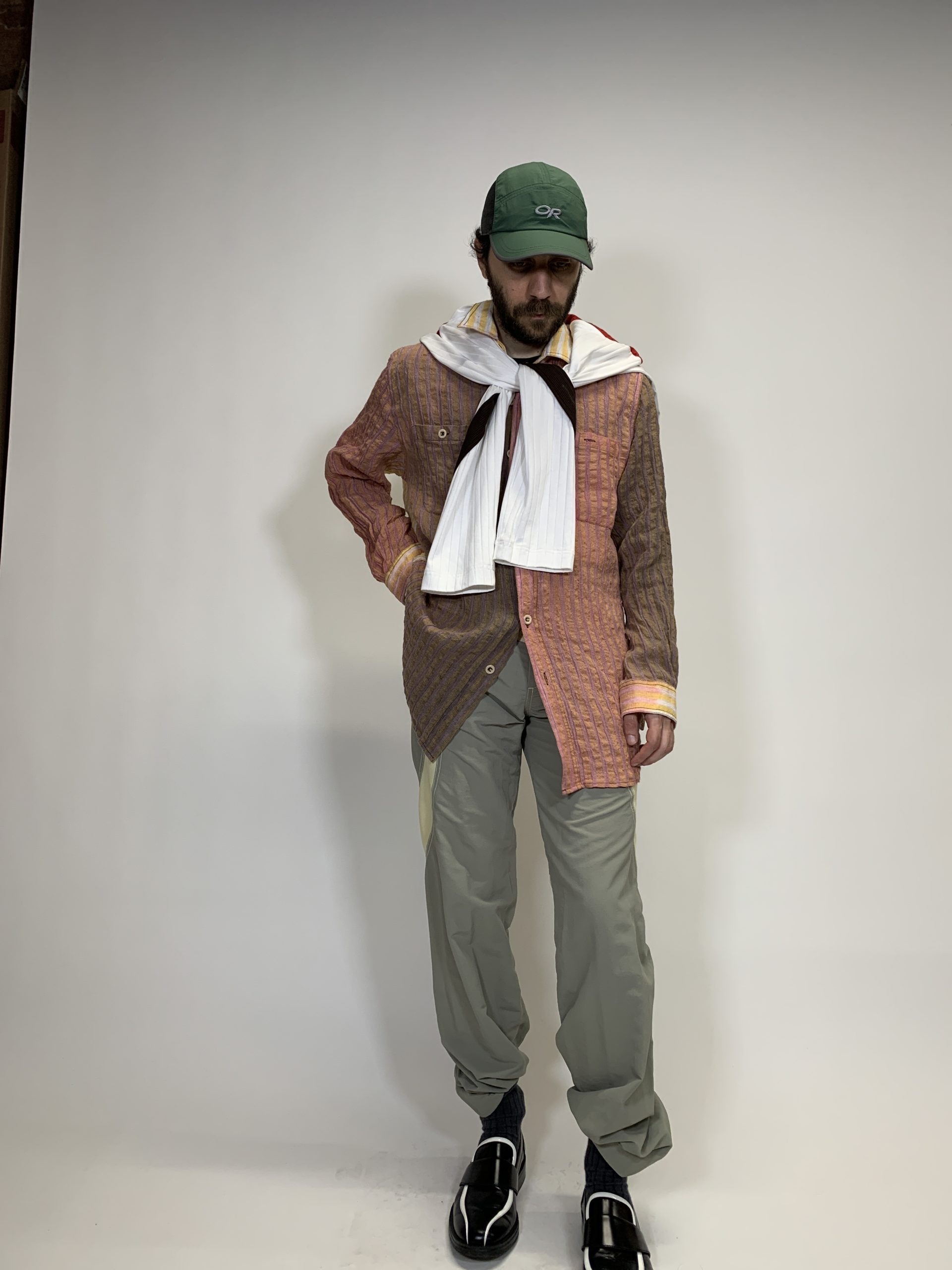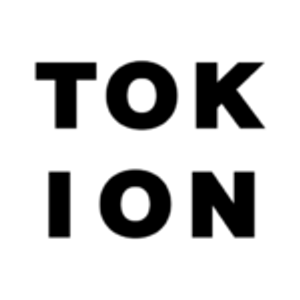Kiko Kostadinov is a garment technician – a fashion designer whose deep curiosity for the historical development, modern construction and subversion of menswear has led him to become one of the industry’s most tenable new talents. His collections are elaborate, comprised of silhouettes that question what men’s bodies could and should present as in the 21st century. Viewed separately, his garments are new canvases for the reconfiguration of archetypal sportswear with references that draw from far and wide. Utility clothing and classical tailoring, women’s period costume and sports uniforms are all fair game for his roving eyes and hands, yet it is his own body that Kostadinov turns to time and time again as testing ground for new volumes and shapes. An avid collector of vintage garments, he has amassed an archive of vintage designer and non-designer pieces that constantly feed his experimentation in the studio – allowing him to play with volumes from couture alongside track athletics, archery gear, and other practical men’s clothing tropes that are entirely transformed in his ‘laboratory’ of a studio in North London. Coupled with an avant-garde eye for harmonious colours and a keen interest in new fabric technologies, Kostadinov’s work is layered with multiple meanings, yet the designer is keen not to be labelled – neither as a utility menswear maverick nor a conceptual radicalist. Instead, he’s out to prove there is truth and possibility in his creations – clothes tried and tested by the designer himself.
Dan Thawley (hereinafter “Dan”):As a designer, self-observation and experimentation is an important part of your practice. These images show this explicit relationship between Kiko the embodied man and Kiko Kostadinov the brand.
Kiko Kostadinov (hereinafter “Kiko”):It’s not that I want to put myself in this sort of elite list, but there aren’t so many other designers that I immediately think of who work like me. Most designers are looking for a story elsewhere. To me, there are a few people that I can remember (or who are active at the moment I guess) who do what I do – like Rick Owens, Marc Jacobs or Stefano Pilati. They dress themselves up, they buy something and play with it and then that action reflects on their product and their brand. They just love fashion and clothes so much and they are able to replicate what they wear and turn it into a new proposal. The core is always that when you see them wearing the brand it’s so believable. That’s also why when I am designing, each collection essentially has so much of me in it. It’s not just a story – it is also about silhouette: I am questioning how I would wear this, would that make sense. A lot of other people have stylists and they implicitly trust them – they trust other people. And I think that’s kind of the difference here. No one comes to me with a mood board and says, “That’s cool, let’s do this.” Rather I need to discuss that with myself in the beginning of the season to really believe in something and feel that it is relevant – and then things like the Renaissance or Kenneth Nolan or another inspiration can come in, but the clothes are always rooted in in my curiosity for finding a new fishing jacket, or cycling trousers or a Victorian blouse.
Dan:So, are you your own fit model then?
Kiko:It started when I did my M.A. and when I used to bring a piece to class and the tutor would say that they saw nothing of me in what I was working on. When you are in fashion school you always make that extra, extra effort to dress up because you are there. My tutors would say “You have so much knowledge, you go to japan, you buy vintage, you are constantly shopping on the internet or going to Portobello Market to research – you just need to look at yourself and to have that confidence.” I never really thought like that before, in fact I thought it was quite lame and self-indulgent. They were not so nice to me. They were disappointed. Like, “You‘ve found all these resources and you can’t even use it. They were basically saying “If you can‘t find a way to tune it in, you are going to waste your passion and talent because nothing’s going to happen.” And they were very hard on me – it was a bit like “it’s now or never to really switch on that button where you can be confident in yourself and what you wear and what you represent.” So, it was very tough because you don’t know yourself if it actually makes sense until you make a collection and other people wear it and can relate.
Dan:How did that translate into your collections?
Kiko:Until that point it was just about trusting in yourself, so it was really the catalyst for pushing into that. The first few seasons were very much kind of reflection on workwear and utility. And then I felt like people put me in a box. That’s when I knew I needed to push further. The risk to repeat ideas and concepts was there but I realised how exciting it was to challenge myself visually with other things, and slowly building my team has helped with that. That said, sometimes I give too much room to them and I have to come back in and shake things up and make it a bit more myself again.
Dan:Can you explain how your curiosity has evolved? Do you still practice the same research processes? Do you still collect physical garments or is it more about imagery now?
Kiko:Maybe it was more visual then, and more practical and physical now. So in a way sampling has become a lot more physical because I am very 3D oriented in terms of making stuff, looking inside garments, checking the quality of the buttons, the pocketing, the herringbone tape used for certain bonding. Before, I had to really think if I could afford to buy a special vintage piece – now I am in more of a position to be able to invest, because if it becomes a piece then it will be worth it, and it will pay for itself. Each season if I pick a silhouette or a garment, then I will wear the vintage piece around the studio in my day to day life, to get into character and understand how it could work – for example a really long shirt under a cropped jacket with tights underneath and maybe sandals. I try and push and push a look like that in my head until it becomes more believable. I would say that my first three seasons were made up of more accepted garments – things you don’t need to play with as much. Like an oversized parka jacket with bulky trousers, or a utility shirt with a hat or something – these were all looks that already existed and were current in fashion, it wasn’t such a new proposal. Now it’s really interesting to see how customers react to a new proposition when it gets into stores.
Dan:What are some of the more unusual purchases that you have made over the years?
Kiko:Each season there are quite a few important pieces. But if something is too weird though I don’t see the potential for it to become a part of my reality. I like things that are borderline. Almost like Helmut Lang’s mentality – the idea of putting in the research and the time to find something really interesting and then just changing the fabric and the proportions to take it out of context. Perhaps it was a very rare military jacket from a particular war or something that he stripped back and turned into a very minimal black poplin jacket that could be worn every day. Sometimes I try to adopt this mentality too.
Kiko Kostadinov
Menswear designer behind the acclaimed eponymous label based in London. His work, focused on innovative pattern cutting, attention to detail and intricate garment construction, aims to challenge and contribute to contemporary menswear aesthetics.
Dan Thawley
Editor in chief of A Magazine Curated By. A wider interest in the arts and discovering young fashion talent has led to freelance contributions for international titles including American Vogue, Vogue Italia, Interview Magazine, i-D, GQ China and Anogher Magazine.
Text and Interview Dan Thawley
Self Portrait Kiko Kostadinov
Edit Takuhito Kawashima(kontakt)
Editorial Support Junsuke Yamasaki(MATT.)




